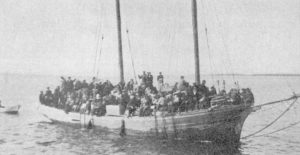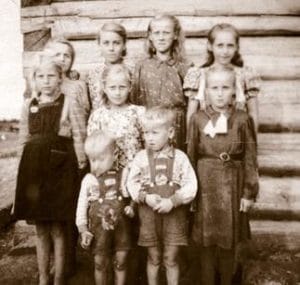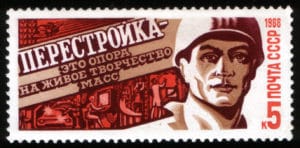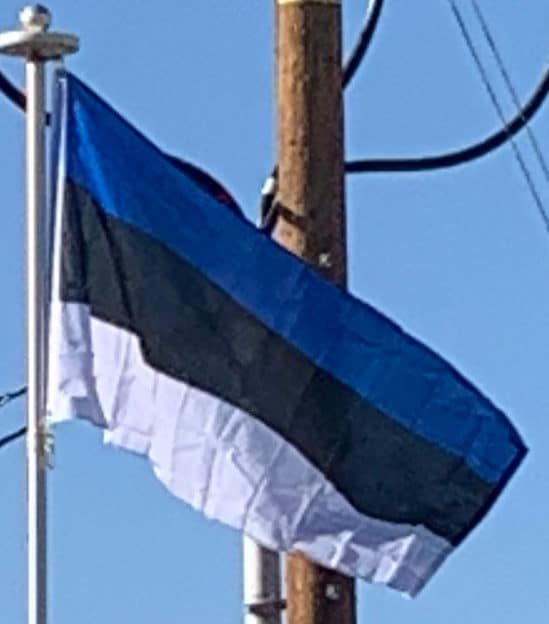The Red Army reached the Estonian borders again in early 1944, but its advance into Estonia was stopped in heavy fighting near Narva for six months by German forces, including numerous Estonian units. In March, the Soviet Air Force carried out heavy bombing raids against Tallinn and other Estonian towns. In July, the Soviets started a major offensive from the south, forcing the Germans to abandon mainland Estonia in September, with the Estonian islands being abandoned in November. As German forces were retreating from Tallinn, the last pre-war prime minister Jüri Uluots appointed a government headed by Otto Tief in an unsuccessful attempt restore Estonia’s independence. Tens of thousands of people, including most of the Estonian Swedes, fled westwards to avoid the new Soviet occupation.

Overall, Estonia lost about 25% of its population through deaths, deportations and evacuations in World War II. Estonia also suffered some irrevocable territorial losses, as Soviet Union transferred border areas comprising about 5% of Estonian pre-war territory from the Estonian SSR to the Russian SFSR.
Soviet Period:
Thousands of Estonians opposing the second Soviet occupation joined a guerrilla movement known as Forest Brothers. The armed resistance was heaviest in the first few years after the war, but Soviet authorities gradually wore it down through attrition, and resistance effectively ceased to exist in the mid 1950s. The Soviets initiated a policy of collectivisation, but as peasants remained opposed to it a campaign of terror was unleashed. In March 1949 about 20,000 Estonians were deported to Siberia. Collectivization was fully completed soon afterwards.

The Soviet Union began Russification, with hundreds of thousands of Russians and people of other Soviet nationalities being induced to settle in Estonia, which eventually threatened to turn Estonians into a minority in their own land. In 1945 Estonians formed 97% of the population, but by 1989 their share of the population had fallen to 62%. Economically, heavy industry was strongly prioritized, but this did not improve the well-being of the local population, and caused massive environmental damage through pollution. Living standards under the Soviet occupation kept falling further behind nearby independent Finland. The country was heavily militarized, with closed military areas covering 2% of territory. Islands and most of the coastal areas were turned into a restricted border zone which required a special permit for entry.
The United States, United Kingdom, France, Germany, and the majority of other Western countries considered the annexation of Estonia by the Soviet Union illegal. Legal continuity of the Estonian state was preserved through the government-in-exile and the Estonian diplomatic representatives which Western governments continued to recognize.
Restoration of Independence:
The introduction of Perestroika in 1987 made political activity possible again, starting an independence restoration process known as the Singing Revolution.

The environmental Phosphorite War campaign became the first major protest movement against the central government. In 1988 new political movements appeared, such as the Popular Front of Estonia which came to represent the moderate wing in the independence movement, and the more radical Estonian National Independence Party, which was the first non-communist party in the Soviet Union and demanded full restoration of independence. Reformist Vaino Väljas became the first secretary of Estonian Communist Party, and under his leadership on 16 November 1988 Estonian Supreme Soviet issued Sovereignty Declaration asserting the primacy of Estonian laws over Union laws. Over the next two years almost all other Soviet Republics followed the Estonian lead issuing similar declarations. On 23 August 1989 about 2 million Estonians, Latvians and Lithuanians participated in a mass demonstration forming a Baltic Way human chain across the three republics. In 1990 the Congress of Estonia was formed as representative body of Estonian citizens. In March 1991 a referendum was held where 77.7% of voters supported independence, and during the coup attempt in Moscow Estonia declared restoration of independence on 20 August, which is now the Day of Restoration of Independence, a national holiday.
